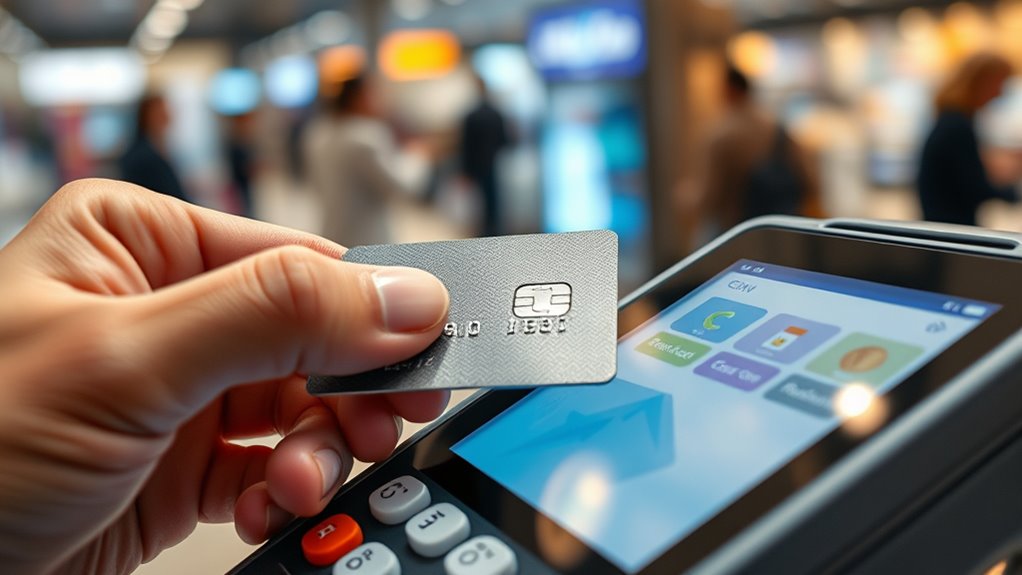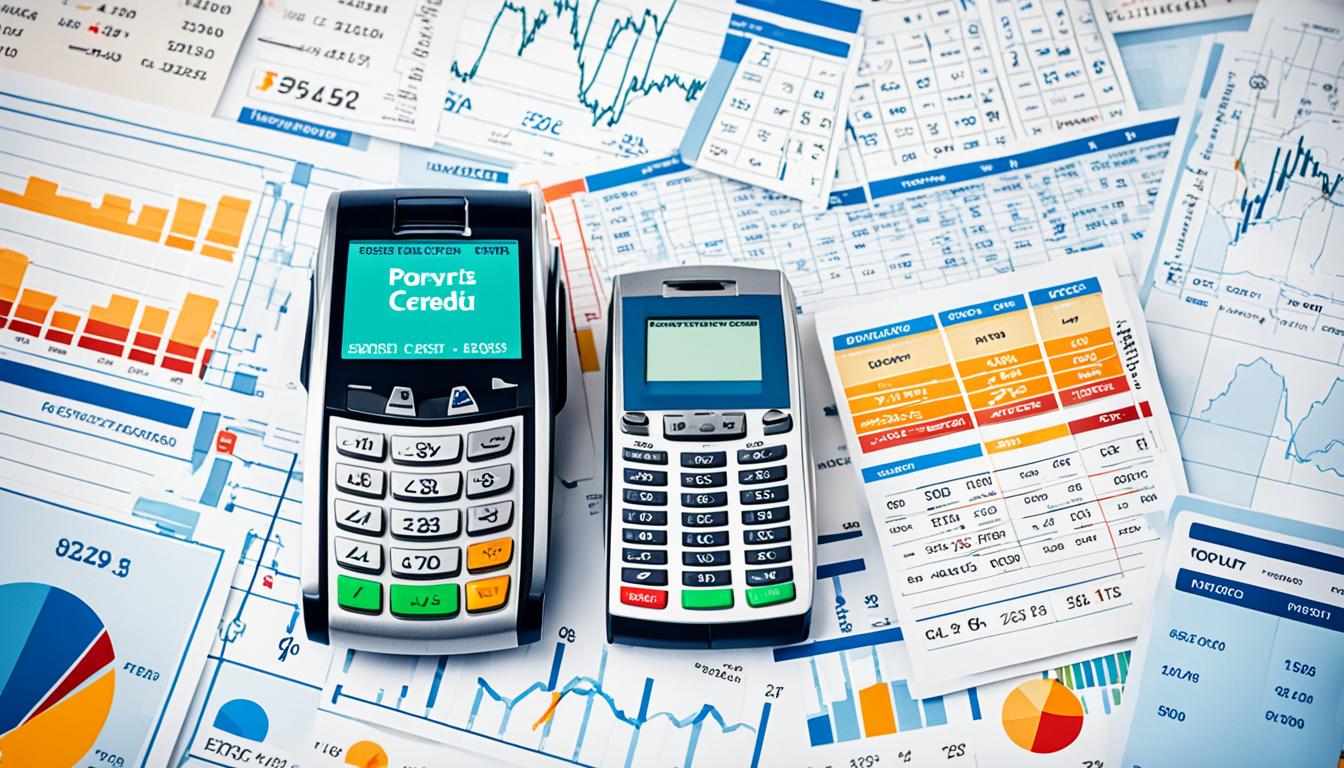Embracing EMV chip cards has transformed payment processing by boosting security and cutting fraud risks. These cards encrypt transaction data uniquely, making counterfeit and stolen card fraud much harder. They also promote global interoperability, allowing seamless transactions across different countries and merchants. Contactless options further speed up payments and reduce contact. If you want to understand how these innovations impact your payments and security, there’s more to explore about the benefits and future trends of EMV technology.
Key Takeaways
- EMV chip cards encrypt transaction data uniquely, significantly reducing counterfeit fraud and enhancing payment security globally.
- The widespread adoption of EMV has led to faster, more reliable, and contactless payment options for consumers.
- Standardized EMV technology improves interoperability across payment networks and supports multiple transaction types.
- Transition to EMV required costly infrastructure upgrades, prompting faster adoption among larger banks and gradual implementation by smaller institutions.
- EMV has transformed payment processing by making transactions safer, fostering innovation, and building consumer confidence worldwide.

As the world moves toward more secure and efficient payment methods, embracing EMV chip technology is vital for both consumers and merchants. Today, nearly 14 billion EMV chip cards are in circulation globally, a significant increase from 10.8 billion in 2020. Over 70% of all payment cards issued worldwide are now EMV-enabled, reflecting a widespread shift toward more secure payment options. By the end of 2024, approximately 96.2% of card-present transactions worldwide utilize EMV chip technology, underscoring its dominant role in payment processing. Contactless EMV payments, in particular, have become a retail mainstay, with adoption rates exceeding 90% in markets like Singapore, Australia, and the UK. Even in the US, where adoption has lagged initially, consumer usage of contactless EMV payments approaches 90%, signaling a significant acceptance trend.
EMV chip cards are now used in over 70% of global payment transactions, with contactless payments exceeding 90% adoption in major markets.
The primary advantage of EMV chips lies in security. Unlike magnetic stripes, which store static data vulnerable to skimming and cloning, EMV chips encrypt transaction data uniquely for each purchase. This encryption drastically reduces counterfeit card fraud. For example, US merchants who upgraded to EMV terminals experienced a 76% decline in counterfeit fraud within just three years of the rollout between 2015 and 2018. The technology also minimizes points of fraud by eliminating vulnerabilities associated with magnetic stripe cards and POS malware attacks. As EMV adoption broadens, the overall security of payment networks improves, boosting consumer confidence worldwide. Additionally, liability for fraudulent transactions shifts toward parties that don’t support EMV compliance, creating incentives for merchants and issuers to upgrade quickly. The transition to EMV also encourages innovation in payment authentication methods, such as biometric verification, further enhancing security.
However, shifting to EMV isn’t without challenges. It requires costly infrastructure upgrades, including issuing new cards and installing new payment terminals. Larger banks tend to adopt EMV more rapidly due to resources, while smaller institutions often lag behind because of costs. In the US, estimates from 2015 projected about 75% of credit cards and 40% of debit cards would convert to EMV by 2017, with full migration expected then. Yet, smaller merchants and banks that miss liability shift deadlines face ongoing fraud risks. During the transition period, inconsistent adoption results in a fragmented experience for consumers and merchants alike, complicating the payment landscape.
EMV also standardized global payment processes, fostering interoperability among international card networks and devices. It supports various transaction types, including chip-and-PIN, chip-and-signature, and contactless payments, providing flexibility and security. Although maintaining compliance adds complexity, it also improves transaction authentication. Integration with emerging technologies like mobile wallets built on EMV frameworks expands payment options and convenience. As consumer familiarity with EMV transactions grows, so does trust in the security and speed of payments. The surge in contactless usage post-pandemic highlights the shift toward touch-free, efficient transactions. According to recent data, over 11 billion EMV cards are now in circulation worldwide, demonstrating the widespread adoption of this secure payment technology. The ongoing expansion of EMV adoption is also driven by the increasing emphasis on payment security, which remains a top priority for financial institutions and consumers alike. Overall, adopting EMV has revolutionized payment processing, making transactions safer, faster, and more reliable worldwide.
Frequently Asked Questions
How Do EMV Chip Cards Improve Security Compared to Magnetic Stripe Cards?
You’ll notice that EMV chip cards improve security by generating unique transaction codes each time, making it nearly impossible for fraudsters to reuse data. Unlike magnetic stripe cards, which store static information easy to copy, chip cards encrypt transaction data and require authentication like PINs. This dynamic data, combined with encryption, considerably reduces fraud risks and makes counterfeiting and skimming much more difficult.
What Challenges Do Merchants Face When Transitioning to EMV Technology?
You face hurdles when switching to EMV technology, despite its security benefits. Delays in certification and manufacturing slow down deployment, leaving many merchants with incomplete systems and increased fraud liability. Costs add up—up to $30,000 per location—making upgrades formidable, especially for small businesses. Operational complexities, ongoing certification waits, and evolving tech requirements further complicate the changeover, forcing you to manage risks and costs while aiming for full compliance.
Are There Costs Associated With Upgrading to Emv-Compatible Payment Terminals?
You’ll encounter costs when upgrading to EMV-compatible payment terminals. These include purchasing equipment, which ranges from $200 to $1,000 per unit, or leasing fees around $50 monthly. Additional expenses involve installation, integration with existing systems, employee training, and ongoing security updates. While upfront costs can seem high, promotions, trade-in programs, and the long-term benefits of reduced fraud and faster transactions can make the investment worthwhile.
How Does EMV Adoption Impact Customer Transaction Times?
You might notice that EMV adoption slightly increases transaction times because of the extra steps involved in chip reading and cryptographic processing. However, contactless EMV speeds things up considerably, often nearly instant with tap-to-pay technology. Overall, while some transactions take a bit longer, the enhanced security benefits and faster contactless options mean your experience remains efficient and safer, ultimately improving your checkout process.
What Future Developments Are Expected in EMV Technology?
You might think EMV technology is already secure, but future developments will make it even smarter. Expect enhancements like tokenization and cryptograms to better protect your data. Innovations in dynamic authentication will make fraud nearly impossible. As EMV expands into electric vehicle charging, healthcare, and public services, you’ll experience faster, safer transactions. With ongoing growth at nearly 10% annually, EMV’s evolution promises more seamless, secure payments worldwide.
Conclusion
By adopting EMV chip cards, you’re not just upgrading your payment methods—you’re stepping into a safer future. Think of the chip as a fortress guarding your transactions, turning vulnerability into resilience. Embracing this change isn’t just about technology; it’s about protecting what matters most—your financial security. So, as you adapt to these new cards, remember: change is the seed from which stronger, smarter systems grow. Don’t resist; thrive.









